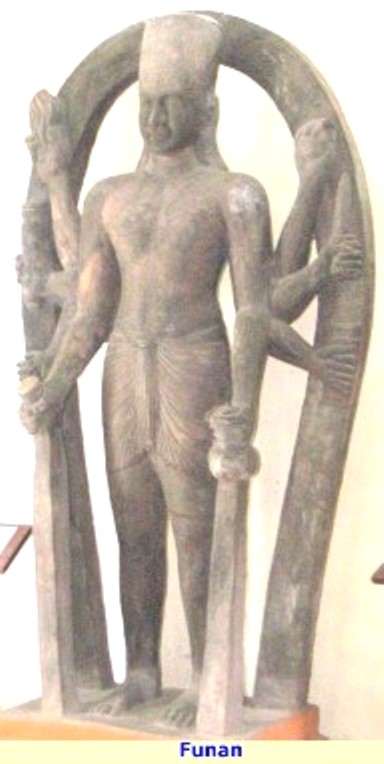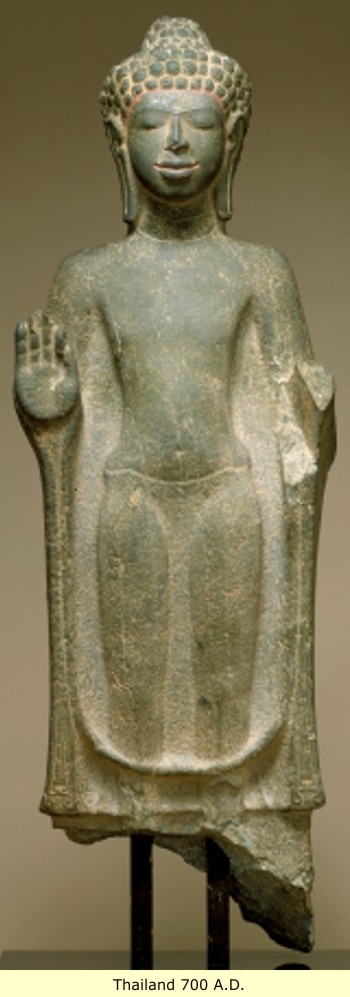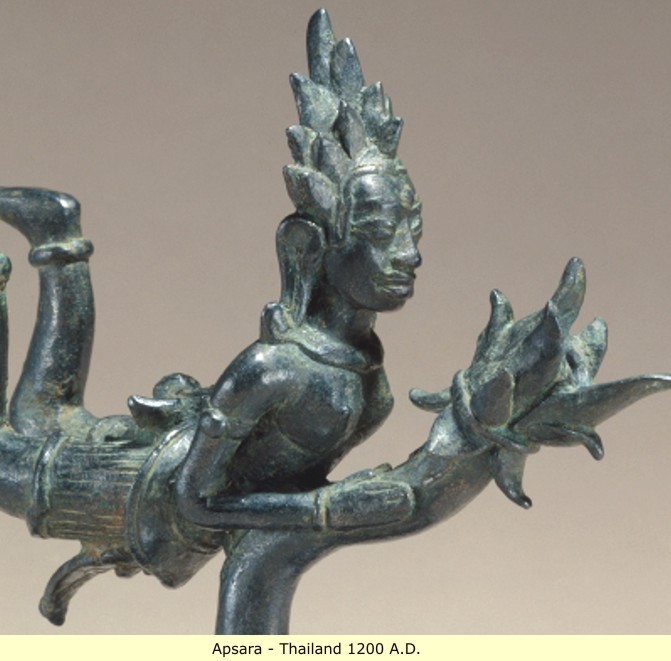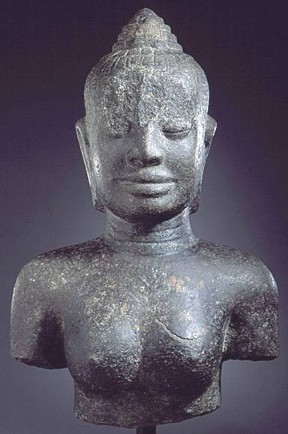Southeast Asia
As we had stated earlier, the people of the Indus valley Civilization did not live only in the Indus Valley. Rather, the extent of that civilization ranged from the Persian Gulf to Southeast Asia. And it is here, in Southeast Asia, that we can perhaps get a glimpse of how these people lived in their "Pure" state.
We will now take a brief look at the poorly researched and little understood "Ancient" civilizations of Thailand, Cambodia, Vietnam and Indonesia.
Ban Chiang
We begin at Ban Chiang, a little town in northern Thailand. Legend has it that Ban Chiang (the archaeological site), was discovered by a clumsy American college student, who fell in the main road of Ban Chiang and noticed ceramics eroding out of the roadbed. The first excavations at the site were conducted in 1967 by archaeologist Vidya Intakosai, this and subsequent excavations by the Fine Arts Department in Bangkok and the University of Pennsylvania, under the direction of Dr. Chester F. Gorman and Pisit Charoenwongsa, have revealed evidence of a prehistoric occupation beginning possibly as early as 3,600 B.C. and continuing, until about 200 A.D.


What's really remarkable about Ban Chiang, is that it gives evidence of a people and a culture that was as technologically advanced as any other in the world. Indeed, they had a fully developed Bronze Age metallurgy - But they didn't use it to make weapons. They knew sophisticated building techniques, but did not build great structures. As a matter of fact, they took on none of the trappings of other advanced cultures with sophisticated technology. Even their social organization was easy, they lived in villages, with little social hierarchy. Question: why did they live like that, so simply?
The answer seems to be:
RELIGION! – Organized, Dogmatic, Religion.
From earliest times, religion was the impetus and driving force for the building of the first large structures – Temples. Around these Temples - homes and businesses were built. Around these Temples, homes and businesses, walls were built – Thus were the first Cities created.
And so it appears that the late ascension of these Southeast Asian people, was due to the lack of this requirement - an all-encompassing, unifying religion. Because true to form, once the great Indian religions of Buddhism and Hinduism had been introduced to, and accepted by these civilizations, they took off! They were all devotedly religious – and all of their great structures had a religious context. (The preceding is an observation, nothing more.)
The Mani
 |
| The Mani have lived in the hilly interior of southern Thailand for thousands, perhaps tens of thousands of years. For the last several thousand years at least, they have done so in close association with a succession of later arrivals, Veddoid, Mon-Khmer, Indian, Malay, Mongolid and other groups. Although the Mani do not seem to have intermarried much with outsiders (who mostly despised them), their contact was still close enough for them to have acquired some cultural traits from their neighbours. Yet these tiny groups have, amazingly, done so without losing their separate identity and tribal character. |
The Kingdom of Funan (Cambodia)
 Historically the first Great Southeast Asian kingdom, that we know anything about, is the Khmer kingdom of Funan. Funan was a Cambodian kingdom located around the Mekong delta. We know very little about it, except that it was a powerful seafaring and trading state. This is evidenced by the discovery of Roman, Chinese and Indian goods, found there during archaeological excavations. The capital is thought to initially have been located at Vyadhapura, near modern Phnom Penh, Cambodia.
Historically the first Great Southeast Asian kingdom, that we know anything about, is the Khmer kingdom of Funan. Funan was a Cambodian kingdom located around the Mekong delta. We know very little about it, except that it was a powerful seafaring and trading state. This is evidenced by the discovery of Roman, Chinese and Indian goods, found there during archaeological excavations. The capital is thought to initially have been located at Vyadhapura, near modern Phnom Penh, Cambodia.The Funanese Empire reached its furthest extent under the rule of one "Fan Shih-man" in the early third century A.D. At this time, Funan extended as far south as Malaysia and as far west as Burma. The Funanese established a strong system of mercantilism and commercial monopolies, that would become the pattern for future empires in the region. Fan Shih-man expanded the Funan fleet, and improved the Funanese bureaucracy, establishing a quasi-feudal system that left local customs and identities largely intact, particularly in the empire's farthest reaches.
 |  |
The Funan kingdom is said to have been heavily influenced by Indian culture, Sanskrit was the language at the court, and the Funanese advocated Hinduism. Later, after the fifth century, also Buddhism. Records show that taxes were paid in silver, gold, pearls, and perfumed wood. Chinese merchants reported that the Funanese practiced slavery and that justice was rendered through trial by ordeal, including such methods as carrying a red-hot iron chain, and retrieving gold rings and eggs from boiling water.
The Mon of Thailand
In about 600 A.D, the Champa of Vietnam (more about them later), sacked Funan and brought it under vassalage. This turn of events allowed the "Mon" of Thailand to break away from Funanese vassalage and establish their own kingdoms. The most important of these Mon kingdoms was Dvaravati, which dates from approximately the 6th to the 11th century A.D. It was centered at the Chao Phraya River valley in modern-day Thailand, with Nakhon Pathom as the capital.
 |  |
The Mon were rarely politically dominant, but rather, almost continually under the shadow of their stronger neighbors. Dvaravati was prevented by geo-political barriers from establishing close political ties with other Mon states to the west in southern Myanmar (Burma), and with the Mon state in northern Thailand. Consequently, Dvaravati experienced political domination by neighboring peoples on at least three separate occasions: in the 10th century, the Burmese conquered the Mon state of Thaton, which was west of the Tenasserim Yoma; from 1100 A.D. to the 1300 A.D, the Khmer (in Cambodia) arose in the east and re-established their Empire; and finally, in the late 13th century, when Dvaravati was absorbed by the current inhabitants of Thailand – the Mongol Thai's.
 |
The Thai were a Mongol people who had already emigrated from southern China during the 9th and 10th century's, and had at first founded only small settlements which were then under Khmer hegemony. In the beginning of the 13th century, they gradually succeeded in becoming free of the reign of the Khmer, who had previously conquered the Mons.
 |  |  |
The first Thai kingdom was Sukothai in the Central Plains of Thailand, from which originated the modern Thai culture, which is a blend of Mongol and Mon. The Thai alphabet and script were developed during this Sukothai period.
Subjugation did not mean immediate extinction for the Mon however, it appears that the Thai allowed the Mon to retain their customs and a relative degree of racial homogeneity for a time. Of course that could not last very long, naturally there would be cross-breeding. And today, it would be very difficult to find a Thai with purely Mongol blood or one with purely Mon blood.
Modern Thailand People
 |  |  |  |
No comments:
Post a Comment